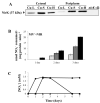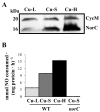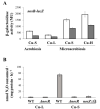Effect of Copper on Expression of Functional Genes and Proteins Associated with Bradyrhizobium diazoefficiens Denitrification
- PMID: 35328804
- PMCID: PMC8951191
- DOI: 10.3390/ijms23063386
Effect of Copper on Expression of Functional Genes and Proteins Associated with Bradyrhizobium diazoefficiens Denitrification
Abstract
Nitrous oxide (N2O) is a powerful greenhouse gas that contributes to climate change. Denitrification is one of the largest sources of N2O in soils. The soybean endosymbiont Bradyrhizobium diazoefficiens is a model for rhizobial denitrification studies since, in addition to fixing N2, it has the ability to grow anaerobically under free-living conditions by reducing nitrate from the medium through the complete denitrification pathway. This bacterium contains a periplasmic nitrate reductase (Nap), a copper (Cu)-containing nitrite reductase (NirK), a c-type nitric oxide reductase (cNor), and a Cu-dependent nitrous oxide reductase (Nos) encoded by the napEDABC, nirK, norCBQD and nosRZDFYLX genes, respectively. In this work, an integrated study of the role of Cu in B. diazoefficiens denitrification has been performed. A notable reduction in nirK, nor, and nos gene expression observed under Cu limitation was correlated with a significant decrease in NirK, NorC and NosZ protein levels and activities. Meanwhile, nap expression was not affected by Cu, but a remarkable depletion in Nap activity was found, presumably due to an inhibitory effect of nitrite accumulated under Cu-limiting conditions. Interestingly, a post-transcriptional regulation by increasing Nap and NirK activities, as well as NorC and NosZ protein levels, was observed in response to high Cu. Our results demonstrate, for the first time, the role of Cu in transcriptional and post-transcriptional control of B. diazoefficiens denitrification. Thus, this study will contribute by proposing useful strategies for reducing N2O emissions from agricultural soils.
Keywords: Cu-containing nitrite reductase; enzymatic activity; gene expression; nitric oxide reductase; nitrous oxide reductase; periplasmic nitrate reductase.
Conflict of interest statement
The authors declare no conflict of interest.
Figures







Similar articles
-
The copper-responsive regulator CsoR is indirectly involved in Bradyrhizobium diazoefficiens denitrification.FEMS Microbiol Lett. 2023 Jan 17;370:fnad084. doi: 10.1093/femsle/fnad084. FEMS Microbiol Lett. 2023. PMID: 37573143 Free PMC article.
-
Regulation of the Emissions of the Greenhouse Gas Nitrous Oxide by the Soybean Endosymbiont Bradyrhizobium diazoefficiens.Int J Mol Sci. 2022 Jan 27;23(3):1486. doi: 10.3390/ijms23031486. Int J Mol Sci. 2022. PMID: 35163408 Free PMC article.
-
The complete denitrification pathway of the symbiotic, nitrogen-fixing bacterium Bradyrhizobium japonicum.Biochem Soc Trans. 2005 Feb;33(Pt 1):141-4. doi: 10.1042/BST0330141. Biochem Soc Trans. 2005. PMID: 15667287
-
Denitrification in Sinorhizobium meliloti.Biochem Soc Trans. 2011 Dec;39(6):1886-9. doi: 10.1042/BST20110733. Biochem Soc Trans. 2011. PMID: 22103545 Review.
-
Fungal denitrification and nitric oxide reductase cytochrome P450nor.Philos Trans R Soc Lond B Biol Sci. 2012 May 5;367(1593):1186-94. doi: 10.1098/rstb.2011.0335. Philos Trans R Soc Lond B Biol Sci. 2012. PMID: 22451104 Free PMC article. Review.
Cited by
-
Molecular and Dual-Isotopic Profiling of the Microbial Controls on Nitrogen Leaching in Agricultural Soils under Managed Aquifer Recharge.Environ Sci Technol. 2023 Aug 1;57(30):11084-11095. doi: 10.1021/acs.est.3c01356. Epub 2023 Jul 19. Environ Sci Technol. 2023. PMID: 37467434 Free PMC article.
-
The copper-responsive regulator CsoR is indirectly involved in Bradyrhizobium diazoefficiens denitrification.FEMS Microbiol Lett. 2023 Jan 17;370:fnad084. doi: 10.1093/femsle/fnad084. FEMS Microbiol Lett. 2023. PMID: 37573143 Free PMC article.
-
Nitric Oxide, Nitric Oxide Formers and Their Physiological Impacts in Bacteria.Int J Mol Sci. 2022 Sep 15;23(18):10778. doi: 10.3390/ijms231810778. Int J Mol Sci. 2022. PMID: 36142682 Free PMC article. Review.
References
-
- IPCC . Summary for policymakers. In: Shukla P.R., Skea J., Calvo Buendía E., Masson-Delmotte V., Pörtner H.-O., Roberts D.C., Zhai P., Slade R., Connors S., van Diemen R., et al., editors. Climate Change and Land: An IPCC Special Report on Climate Change, Desertification, Land Degradation, Sustainable Land Management, Food Security, and Greenhouse Gas Fluxes in Terrestrial Ecosystems. Intergovernmental Panel on Climate Change; Geneva, Switzerland: 2019.
MeSH terms
Substances
Supplementary concepts
LinkOut - more resources
Full Text Sources
Molecular Biology Databases
Research Materials

